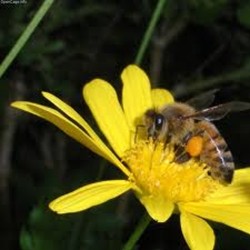You’ve probably heard that bees are our friends, pollinating many crops that we depend on for food – and for our state’s economy. To name just one, almonds, pollinated by bees, comprise a $1 billion California crop. You’ve probably also heard that bees are in trouble, dying off in mysterious collapses of entire colonies over the last decade.
Many causes for these die-offs have been proposed, such as pesticides, mites, monoculture, pollution, viruses, and the stress of being shipped from one place to another to pollinate farms and orchards whose own bees have died. Frankly, I have always suspected that the confluence of all these factors has simply made life too difficult for our bee allies. A report in last month’s issue of Ground Truth, a publication of the Pesticide Action network, states, “The current consensus, however, is that the die-offs are likely driven by a causal complex in which pesticides, pathogens and nutrition each play a role.”
 The weirdest thing I just learned about this (via the same report) is that bees near corn fields get the pesticide clothianidin not only from dust, soil, and pollen, but also from a process called, amazingly, “planter exhaust.” This occurs as follows: “Corn seeds are sown using an automated planting system that relies on air/vacuum mechanisms to space the seeds; in order to keep seeds treated with pesticides from sticking to one another, talc is used. This talc becomes contaminated and is then exhausted during planting, either down with the seed or into the air.”
The weirdest thing I just learned about this (via the same report) is that bees near corn fields get the pesticide clothianidin not only from dust, soil, and pollen, but also from a process called, amazingly, “planter exhaust.” This occurs as follows: “Corn seeds are sown using an automated planting system that relies on air/vacuum mechanisms to space the seeds; in order to keep seeds treated with pesticides from sticking to one another, talc is used. This talc becomes contaminated and is then exhausted during planting, either down with the seed or into the air.”
Now what? Well, we can tackle the human-caused threats one by one, starting with pesticides. We consumers can play a key role by shifting our food dollars to foods produced with minimal chemical assistance (aka organic).
